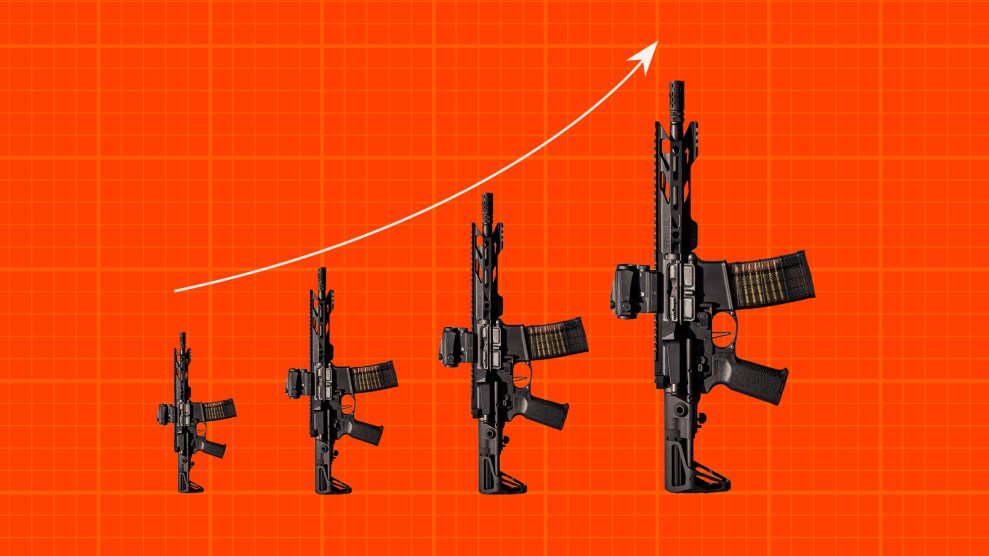
Mother Jones; Getty
With Nashville still reeling from a devastating mass shooting two weeks ago at an elementary school, the latest such carnage in America, unleashed inside a Louisville bank on Monday, featured the same type of highly lethal weapon. A source familiar with the ongoing investigation into Monday’s attack confirmed to me that the gunman used an AR-15 rifle, a popular firearm that was originally developed for use in war.
The Louisville attack is the latest in a troubling trend: It is the seventh mass shooting in the past 11 months alone to be carried out with an AR-15.
According to our Mother Jones database, there have been 36 mass shootings since 2012 using AR-15s, dating to the massacres just over a decade ago at a movie theater in Colorado and at Sandy Hook Elementary School in Newtown, Connecticut. Those three dozen massacres resulted in the deaths of 58 victims, more than 106 people injured, and communities traumatized from New York and Texas to Tennessee, Kentucky, and beyond. The steepest toll from a shooter wielding an AR-15 in these attacks was at Robb Elementary School in Uvalde, Texas, where 19 children and two teachers died and at least 17 other people were injured—and where police failed to act in part because they feared the shooter’s AR-15.
The gunman in Louisville, identified by local authorities as Connor Sturgeon, 25, was an employee of Old National Bank, where he struck; he killed five people and injured at least eight others, including two responding police officers, before dying in a shootout with police.
As I reported after the Nashville mass shooting in late March:
Semiautomatic pistols used to be the top weapon of choice for mass shooters. But ever since the massacres at a Colorado movie theater and a Connecticut elementary school just over a decade ago, many perpetrators of these crimes have armed themselves with AR-15s and caused growing carnage. The phenomenon accelerated further with five high-profile attacks in 2022, beginning with those in Buffalo and Uvalde. (In the several years prior: the massacres in Las Vegas, Sutherland Springs, Parkland, Pittsburgh, Gilroy, El Paso, Dayton, Boulder, Indianapolis—the list quickly grows long.) Mass shooters increasingly also use body armor, tactical vests, and other tactical gear, the Nashville perpetrator included.
This disturbing trend connects in part to how mass shooters emulate previous attackers as they plan and prepare, one of multiple common warning behaviors I examine in Trigger Points, my book about preventing mass shootings through the method of threat assessment. The weapons and gear these perpetrators select has coincided with aggressive marketing tactics long used by the gun industry.
Sturgeon’s age and actions figure into other behavioral patterns seen with mass shooters. According to the Louisville police chief, he live-streamed footage of his attack on Instagram, which authorities quickly sought to have removed by the social media platform. His live-streaming further reflects emulation behavior and has also been an escalating phenomenon, marking the Buffalo attack and others.
On Monday, CNN and and local TV news outlets reported on the shooter’s gun, with descriptions including “an AR-15-style rifle” and an “assault weapon.” Local authorities, however, only specified publicly that the weapon was “a rifle.” It is unclear why the Louisville Metro PD withheld details about the firearm or why the agency referred to the gunman in multiple tweets on Monday as an “active aggressor” (a term that I have not seen used previously in the context of mass shootings). On Tuesday morning, Louisville Mayor Craig Greenberg also confirmed that the shooter used an AR-15, which the shooter purchased legally at a gun dealership in Louisville on April 4, six days prior to the attack. Most mass shooters use legally obtained firearms.
The gun industry estimates that at least 20 million AR-15s are in circulation throughout the country, according to a recent series on the firearm from the Washington Post. Nearly 14 million of those rifles were manufactured by US gun companies over the past decade, generating sales revenues of roughly $11 billion.
AR-15s can do horrific damage: The velocity and impact of the .223-caliber rounds can blast apart organs and demolish bones, as the Post illustrated with videos that are harrowing to watch—even just as animated visualizations. The bodies of some children killed in Uvalde were so obliterated that authorities had to resort to DNA testing to identify those victims.
Kentucky has some of the loosest gun policies in the United States. The state does not have a “red flag” law, a provision allowing authorities to remove guns from people who indicate through various warning behaviors that they may be planning targeted violence. According to CNN, a troubled Sturgeon wrote a note to his parents and a friend indicating that he intended to open fire at the bank. (Further details of those reported communications are not yet clear, including whether they were discovered before or after the attack. On Tuesday, local authorities disclosed that Sturgeon told at least one person that he was suicidal.)
For more on the soaring popularity of AR-15s among American gun buyers—and their increasingly stark role in the nation’s mass shootings epidemic—listen to this in-depth conversation I participated in recently on KQED’s “Forum.”
This article has been updated with details about the perpetrator’s gun.












